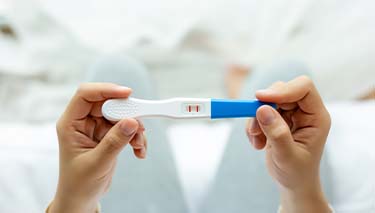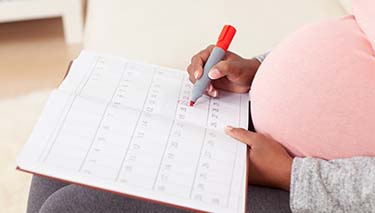Spotting is generally related to any vaginal bleeding in-between a period. Many women will have spotting for a few days before their period starts and this can be very normal. Infection, hormonal changes and trauma can all result in spotting.
Spotting can also happen during pregnancy and is fairly common – around 20% of women experience spotting in their first trimester (12 weeks). Some women experience spotting throughout their entire pregnancy.
Spotting, particularly during pregnancy, can be very scary. Any bleeding during pregnancy, no matter how light, is worth getting checked by a healthcare professional.
What’s the Difference Between Spotting and Bleeding?
Spotting is when a few drops of blood is seen on underwear or on toilet paper after wiping. It’s similar to the amount of blood you’d see as your period ends. Spotting may be mixed in with vaginal mucous and appear as spots or streaks. Spotting can vary in colour from pink to red and be the colour of old brown blood. It’s not enough to cover a panty liner and may stop and start. If spotting has been caused by an implantation bleed, the colour may be similar to the start of a period.
Generally, there is no pain with an implantation bleed. Unlike the start of a period where it’s common for women to have cramping and/or a backache.
Bleeding during pregnancy means there is a heavier flow of blood, enough to wear a tampon or pad to absorb the blood. It tends to be more constant and is bright red. Reassuringly, around 50% of women who have bleeding during pregnancy will go on to have a healthy pregnancy and baby.
What Causes Pregnancy Spotting?
In the First Trimester
There are a few reasons for spotting during pregnancy, especially in the early weeks when there are lots of hormonal changes. Some women notice spotting at around the time their period may have been due, expecting it to progress to a normal period. If it is unusually light and does not last as long as a normal period, it may instead be an implantation bleed.
Spotting in the first trimester is more common than the second and third trimesters.
- An implantation bleed can occur as the embryo nestles into the uterine lining, this most commonly happens around 6-12 days after conception. Implantation bleeding is generally only light and settles within a few hours up to three days.
- Vaginal, uterine or cervical infection. Not all symptoms of infection are obvious and may only be detected through a blood test or a swab.
- Some medications such as blood thinners can increase the risk of pregnancy bleeding.
- Cervical polyp – this is a small harmless growth of cells on the cervix. High oestrogen levels can increase the risk of cervical bleeding during pregnancy, especially after intercourse or a vaginal examination.
- Lifting heavy objects, excessive exercise or exertion.
- May be the early signs of miscarriage. Around 1 in 5 pregnancies ends in miscarriage.
- Ectopic pregnancy.
- Unknown causes.
In Second and Third Trimesters
- Miscarriage.
- Placenta praevia – this is where the placenta is lying over, or partly over the cervix and can be a cause for bleeding during pregnancy.
- Other pregnancy complications.
- Premature or early labour.
- Placental abruption – where the placenta starts to come away from the lining of the uterus.
- Molar pregnancy.
- Subchorionic bleed – this happens when blood collects in the folds of the outer foetal membrane next to the placenta, or between the uterus and the placenta.
- Onset of labour if close to term.
What to do if You’re Spotting During Pregnancy
- Contact your healthcare provider. You may need to have an ultrasound to see if a cause can be found. You could also need a blood test to check your levels of hCG –Human Chorionic Gonadotrophin, the pregnancy hormone.
- Take someone with you to your medical appointment. This is a time when you may need the support of your partner or a trusted relative or friend.
- Speak with your healthcare provider about your blood group. If you have a Negative blood group you may need to have an injection of Anti-D if you’re bleeding during pregnancy.
- Let your healthcare provider know if you develop an elevated temperature of have any uterine cramping.
- Wear a pad, not a tampon. Make a note of the time you change each pad so you can monitor your bleeding.
- Try to take things easy for a few days. Avoid strenuous exercise and rest where possible.
- Drink plenty of water and stay well hydrated.
- Elevate your feet if you can.
What to do if You’re Bleeding During Pregnancy
- Make an appointment with your healthcare provider as soon as possible.
- If you’re bleeding heavily and are worried, call an ambulance.
- Try to collect any clots or tissue if possible. Take any pads with you for your health check so they can be checked for clots or tissue if present.
Content written and reviewed by Jane Barry, Midwife and Child Health Nurse on November 19 2019.


Last Published* May, 2024
*Please note that the published date may not be the same as the date that the content was created and that information above may have changed since.





















